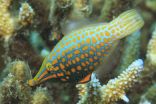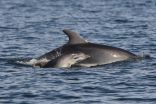(Press-News.org) WEST LAFAYETTE, Ind. - Invasive plant and animal species can cause dramatic and enduring changes to the geography and ecology of landscapes, a study from Purdue University and the University of Kentucky shows.
A review of studies on how life forms interact with and influence their surroundings concluded that invasive species can alter landscapes in myriad ways and with varying degrees of severity. These changes can be quick, large-scale and "extremely difficult" to reverse, said study author Songlin Fei, a Purdue associate professor of quantitative ecology.
"Invaders can change a landscape in long-lasting ways," Fei said. "If we do not keep an eye on them, they could cause serious problems that can have impacts for decades or centuries."
The impact of invasive species - defined by Fei as non-native species that cause economic and ecological damage - on other organisms and the overall species composition of an area has long been recognized. But little work has focused on how invasive species can transform the land they colonize.
Invasive plants, for example, can alter sedimentation rates and change stream channels; insects can modify a landscape by building mounds and burrowing; and animals can accelerate erosion by digging and trampling vegetation.
"This is a subject area that merits more attention," Fei said, noting that the review examines the "geomorphic" effects of invasive species in a neutral way. "We're not saying these changes are positive or negative, but rather, this is what invasive species are doing to the system."
The review showed that areas where land and water systems overlap - such as wetlands, salt marshes, coastal beaches and dunes - are particularly vulnerable to invasive species. The dynamic nature of these areas contribute to the speed and scale with which non-native species can transform the landscape and ecology. Fei pointed to the example of Spartina grass, also known as cordgrass, which was intentionally introduced into coastal mudflats to prevent erosion. In China, the grass quickly transformed about 432 square miles of coastline into salt marshes.
"You basically lose your beach in about a decade," Fei said.
In contrast, forests are often slower to show signs of the impacts of invasive species because of the longer life spans of forest organisms and the slow ecosystem turnover.
The review also established trends in the types of changes that invasive species can cause. Invasive plants primarily construct new structures in a landscape, such as peat bogs or layers of leaf litter, or protect an area from wind or erosion. Invasive animal species also create new structures - examples being beaver dams and termite mounds. In addition, animals move materials and contribute to erosion and sedimentation. Reworking of soil and sediment by earthworms, for example, changes the soil structure up to nearly 7 feet below the surface.
Fei recommended that natural resource managers identify high-risk areas, which could be determined by the type of landscape or the invasive species to which the area is most prone. Whether to restore an area that has already been altered by invasive species can be a difficult decision, he said.
One of the challenges of studying the changes invasive species have on a landscape is the lack of a standard unit for measuring these effects, he said. More research is also needed to better understand the impacts of invasive microbial organisms.
"This is a new frontier in science," he said. "Biogeographers and experts on invasive species need to work together to help quantify these changes."
INFORMATION:
The paper was published in the Annual Review of Ecology, Evolution, and Systematics and is available at http://www.annualreviews.org/doi/pdf/10.1146/annurev-ecolsys-120213-091928.
The National Science Foundation funded the research.
A species of small fish uses a homemade coral-scented cologne to hide from predators, a new study has shown, providing the first evidence of chemical camouflage from diet in fish.
Filefish evade predators by feeding on their home corals and emitting an odor that makes them invisible to the noses of predators, the study found. Chemical camouflage from diet has been previously shown in insects, such as caterpillars, which mask themselves by building their exoskeletons with chemicals from their food. The new study shows that animals don't need an exoskeleton to use chemical ...
Researchers at Loyola University Chicago Stritch School of Medicine may have identified a way to assess who is at risk for developing a urinary tract infection (UTI) following pelvic-floor surgery. These findings were reported in the latest issue of PLOS ONE.
Urinary tract infections (UTIs) are the most common type of bacterial infection and have estimated treatment costs exceeding $1 billion a year in the United States. Women who undergo surgery for pelvic-organ prolapse or urinary incontinence are more likely to develop a UTI following the procedure. Clinicians have ...
Three studies presented by University of Colorado Cancer Center researchers at the San Antonio Breast Cancer Symposium 2014 demonstrate the effects of blocking androgen receptors in breast cancer. One shows that, counterintuitively, blocking the action of androgen receptors reduces the growth of estrogen-positive (ER+) breast cancers. The second study found that even triple-negative breast cancers (TNBCs), which are without known hormone drivers and carry the poorest prognosis, are dependent on androgen receptor activation. And the third study finds that targeting androgen ...
The National Science Foundation (NSF) has awarded Kent State University a $300,000 grant for three College of Arts and Sciences faculty members to study how human dynamics across social media and social networks can be modeled. The grant is part of a $999,887 collaboration with San Diego State University and the University of Arkansas.
Professor Jay Lee and Assistant Professor Xinyue Ye of Kent State's Department of Geography and Associate Professor Ruoming Jin of Kent State's Department of Computer Science will use information diffusion, visualization and simulations ...
Dr. Damon Little, Associate Curator of Bioinformatics in the Cullman Program for Molecular Systematics at The New York Botanical Garden, has just published a new study in the journal Genome investigating the use of DNA barcoding to test the authenticity of Ginkgo biloba (G. biloba), an herbal dietary supplement sold to consumers that is supposed to boost cognitive capacity. Unfortunately, herbal supplements on the market are subject to mislabelling, and therefore consumers may not be getting the products and benefits they believe they are getting.
Dr. Little's research ...
Tampa, FL (Dec. 11, 2014) -- Despite emerging evidence otherwise, many college students consider hookah smoking safer than smoking cigarettes, reports a University of South Florida (USF) College of Public Health study published this month by the Centers for Disease Control and Prevention (CDC).
The study, appearing online in the CDC journal Preventing Chronic Disease, examined the prevalence of hookah use and described social and behavioral factors associated with hookah smoking among students at USF, a large urban public university in Tampa, Fla. The research suggests ...
A cold 'sensor' which triggers the skin's vascular response to the cold could represent an exciting new therapeutic target for the treatment of frostbite and hypothermia, according to scientists at King's College London.
Known to be linked to pain sensitivity and currently used in the development of painkillers, this is the first time the TRPA1 gene has been implicated in the response of blood vessels in the skin to cold. Published today in Nature Communications, the research was funded by the British Heart Foundation and the Biotechnology and Biological Sciences Research ...
The rise in tourism, fishing and sea transport between the Iberian Peninsula and the Balearic Islands is compromising the wellbeing of a small population of common bottlenose dolphins living in coastal waters off the Pityusic Islands. This is the conclusion of a study led by the University of Barcelona (Spain), which has, for the first time, counted these mammals in summer and spring, which are crucial seasons for them.
Despite being one of the most common cetaceans in the Mediterranean Ocean, the common bottlenose dolphin (Tursiops truncatus) resides in areas close to ...
The drive for energy efficient homes could increase asthma risks, according to new research.
Led by a team at the University of Exeter Medical School, the research has found that a failure by residents to heat and ventilate retrofitted properties could lead to more people developing the respiratory condition.
Working with leading UK social housing provider, Coastline Housing, the research team assessed data from the residents of 700 properties in Cornwall. They found that people living in more energy efficient homes had a greater risk of asthma, and that the presence ...
Scientists at Brunel University London have found a way of targeting hard-to-reach cancers and degenerative diseases using nanoparticles, but without causing the damaging side effects the treatment normally brings.
In a huge step forward in the use of nanomedicine, the research helped discover proteins in the blood that disguise nanoparticles so they are absorbed into cells without causing inflammation and destroying healthy cells.
Two studies, Complement activation by carbon nanotubes and its influence on the phagocytosis and cytokine response by macrophages and Complement ...

